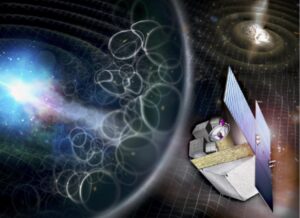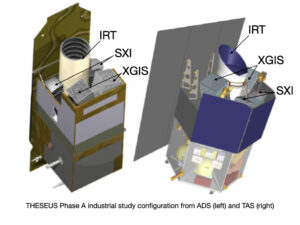THESEUS (Transient High Energy Sky and Early Universe Surveyor) is a mission concept initially proposed in response to ESA’s M5 call for a medium-class mission, and later in the 2018 M7 call, under the Cosmic Vision program, and selected in December 2023 along with two other mission designs for a three-year in-depth phase (“Phase A”). Final selection (“adoption”) of the mission will take place in June 2028, with launch planned for 2037.
The mission is designed to vastly increase the discovery space of the high energy transient phenomena over the entirety of cosmic history. Its primary scientific goals will address the Early Universe ESA Cosmic Vision themes “How did the Universe originate and what is made of?” and will also impact on “The gravitational wave Universe” and “The hot and energetic Universe” themes.
In this context, the main scientific goals of the proposed mission are to:
- Explore the Early Universe (cosmic dawn and reionization era) by unveiling a complete census of the Gamma-Ray Burst (GRB) population in the first billion years, by performing unprecedented studies of the global star formation history of the Universe up to z ~ 10 and possibly beyond; by detecting and studying the primordial (population III) star population; by investigating the re-ionization epoch, the interstellar medium (ISM) and the intergalactic medium (IGM) up to z ~ 8 – 10, and the properties of the early galaxies and determine their star formation properties in the re-ionization era.
- Perform an unprecedented deep monitoring of the X-ray transient Universe in order to locate and identify the electromagnetic counterparts to sources of gravitational radiation and neutrinos, which may be routinely detected in the late ‘20s / early ‘30s by next generation facilities like aLIGO/aVirgo, eLISA, ET, or Km3NET; to provide real-time triggers and accurate (~1′ within a few seconds; ~1″ within a few minutes) locations of (long/short) GRBs and high-energy transients for follow-up with next-generation optical-NIR (E-ELT, JWST if still operating), radio (SKA), X-rays (ATHENA), TeV (CTA) telescopes; to provide a fundamental step forward in the comprehension of the physics of various classes of Galactic and extra-Galactic transients, e.g.: tidal disruption events (TDE), magnetars/SGRs, SN shock break-outs, Soft X-ray Transients SFXTS, thermonuclear bursts from accreting neutron stars, Novae, dwarf novae, stellar flares, AGNs and Blazars; to provide unprecedented insights into the physics and progenitors of GRBs and their connection with peculiar core-collapse SNe and substantially increase the detection rate and characterization of sub-energetic GRBs and X-Ray Flashes;
- Fill the present gap in the discovery space of new classes of high-energy transient events, thus providing unexpected phenomena and discoveries.
These very ambitious goals will be achieved via a unique payload providing an unprecedented combination of
- wide and deep sky monitoring in a broad energy band (0.3 keV – 20 MeV);
- focusing capabilities in the soft X-ray band providing large grasp and high angular resolution;
- on board near-IR capabilities for immediate transient identification and redshift determination.
The foreseen payload of THESEUS includes the following instrumentation:
- Soft X-ray Imager (SXI, 0.3 – 5 keV): a set of 2 lobster-eye telescopes units, covering a total field of view (FOV) of ~0.5 sr with source location accuracy < 1’–2′.
- InfraRed Telescope (IRT, 0.7 – 1.8 μm): a 0.7 m class IR telescope with 15’×15′ FOV, for fast response, with both imaging and spectroscopy capabilities.
- X-Gamma rays Imaging Spectrometer (XGIS, 2 keV – 20 MeV): a set of 2 coded-mask cameras using monolithic X-gamma rays detectors based on bars of Silicon diodes coupled with CsI crystal scintillator, granting a ~2 sr FOV and a source location accuracy of ~10′ in the 2–150 keV, as well as a >4 sr FoV at energies >150 keV.
The mission profile includes: an onboard data handling units (DHUs) system capable of detecting, identifying and localizing likely transients in the SXI and XGIS FOV; the capability of promptly (within a few tens of seconds at most) transmitting to ground the trigger time and position of GRBs (and other transients of interest); and a spacecraft slewing capability of at least 6°/minute. The baseline launcher/orbit configuration is a launch with Vega-C to a low inclination low Earth orbit (LEO, ~600 km, <5°), which has the unique advantages of granting a low and stable background level in the high-energy instruments, allowing the exploitation of the Earth’s magnetic field for spacecraft fast slewing and facilitating the prompt transmission of transient triggers and positions to the ground.
INAF/OAS Bologna is heavily involved in this mission, with the following key roles:
- General mission management (lead proposer/lead scientist L. Amati)
- Overall responsibility of Italian contribution (L. Amati)
- XGIS PI-ship and system lead (L. Amati, C. Labanti)
- TBU responsibility (E. Virgilli)
For more details, see the official mission website and the ESA M5 website.
For more informations: L. Amati, E. Virgilli C. Labanti, R. Campana,


